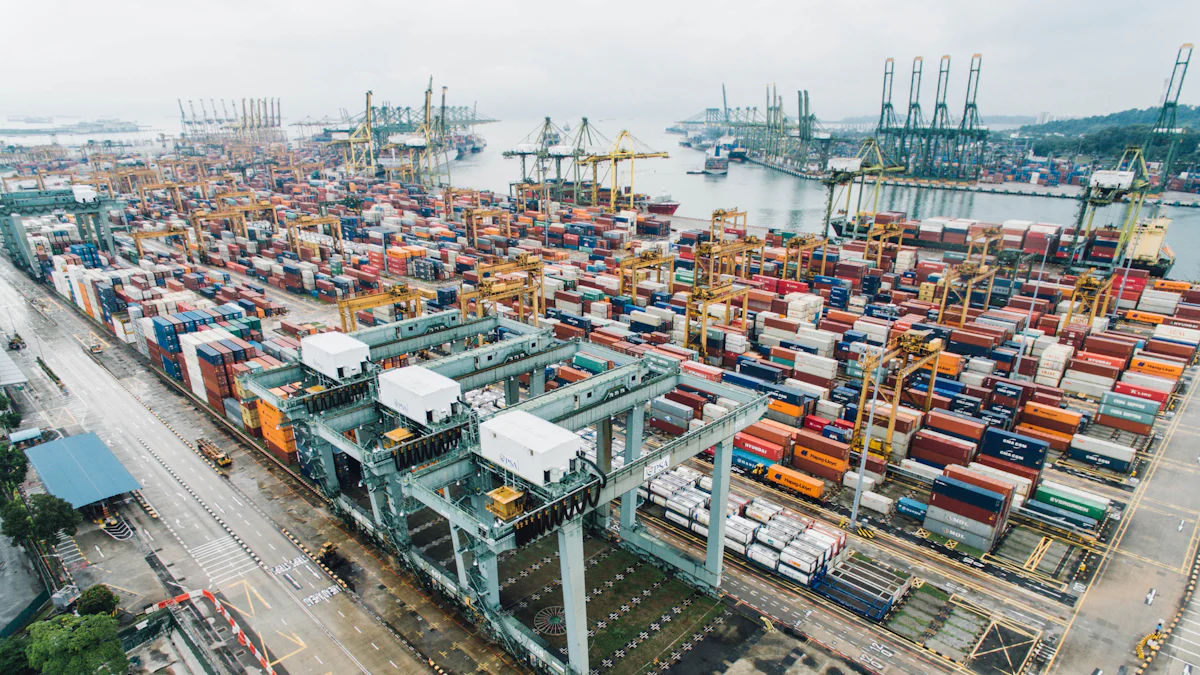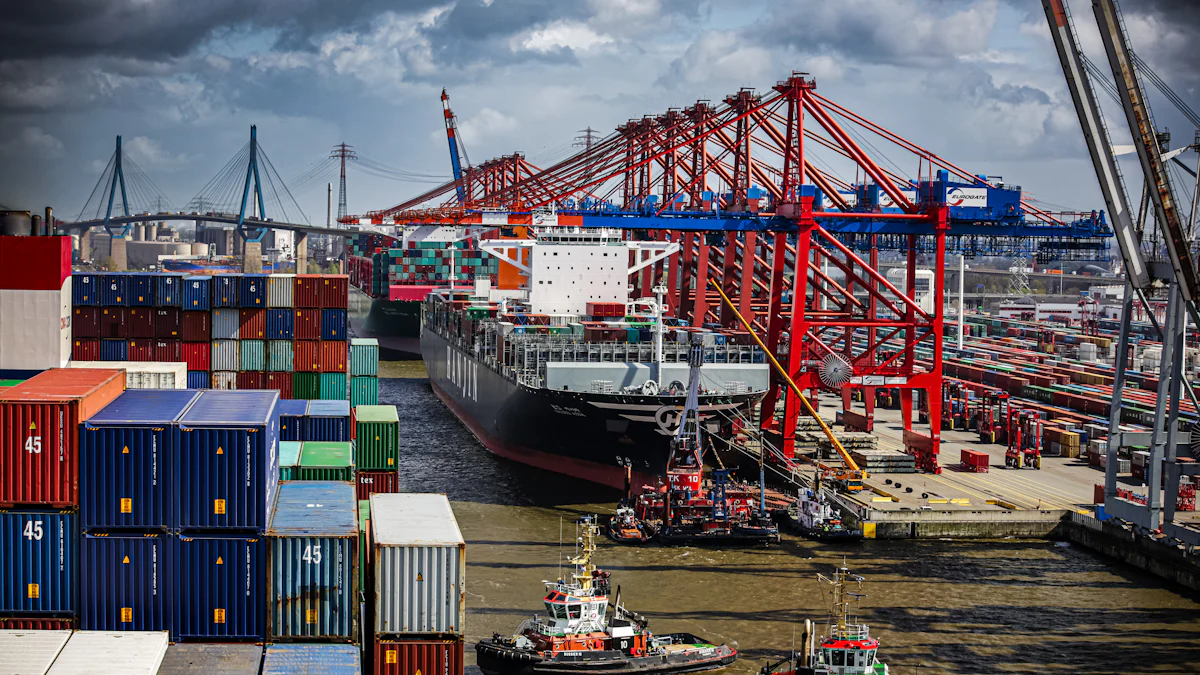Exploring Freight Consolidation Services and Their Advantages

Freight consolidation services streamline logistics by merging smaller shipments into larger ones. This process optimizes space utilization and reduces operational costs by up to 23%. Businesses benefit from cheaper and more efficient shipping, with freight savings reaching 12.4%. Consolidation also lowers emissions, contributing to sustainability efforts. Carriers experience reduced overhead costs and strengthened relationships with shippers. These services enhance the shipping process, making it a vital component in the logistics and transportation industry.
Understanding Freight Consolidation

What is Freight Consolidation?
Definition and Basic Concept
Freight consolidation services involve combining smaller shipments from various clients into a single, larger shipment. This strategy optimizes logistics by reducing costs and improving efficiency. Businesses use consolidation services to streamline their shipping operations and enhance supply chain management. The process allows companies to share transportation resources, resulting in significant savings.
Historical Context and Evolution
Freight consolidation has evolved over the years as a response to increasing demand for cost-effective shipping solutions. In the past, businesses relied on individual shipments, which often led to higher costs and inefficiencies. The introduction of consolidation services marked a shift towards more sustainable and efficient logistics practices. Companies like Flock Freight have pioneered advanced methods, using cutting-edge technology to enhance the benefits of freight consolidation. This evolution reflects the industry's move towards a communal shipping system, prioritizing sustainability and cost-effectiveness.
How Freight Consolidation Works
Process of Combining Shipments
The process of freight consolidation begins with collecting smaller shipments from different clients. These shipments are then combined into a single load, maximizing space utilization. The consolidated shipment travels as one unit, reducing the number of trips required. This method not only cuts costs but also decreases the carbon footprint associated with transportation. Businesses benefit from faster delivery times and improved reliability.
Key Players Involved
Several key players participate in the freight consolidation process. Shippers provide the goods that need transportation. Freight brokers coordinate the consolidation services, ensuring efficient scheduling and routing. Carriers transport the consolidated shipments to their final destinations. Each player plays a crucial role in maintaining the efficiency and effectiveness of the consolidation process.
Types of Freight Consolidation
Full Truckload (FTL) Consolidation
Full Truckload (FTL) consolidation involves combining shipments to fill an entire truck. This method suits businesses with large volumes of goods. FTL consolidation services offer several advantages, including reduced handling and faster transit times. Shippers often receive preferred rates due to the increased volume of goods transported.
Less Than Truckload (LTL) Consolidation
Less Than Truckload (LTL) consolidation caters to businesses with smaller shipment volumes. LTL consolidation services combine multiple smaller shipments into one truckload. This approach provides flexibility, allowing businesses to adjust shipment sizes based on demand. LTL consolidation reduces costs and improves delivery times, making it an attractive option for many companies.
Advantages of Freight Consolidation

Cost Efficiency
Reduction in Shipping Costs
Consolidation services significantly reduce shipping costs by combining smaller shipments into larger ones. Businesses benefit from cheaper shipping rates per item due to efficient space utilization. Larger shipment sizes allow companies to negotiate lower rates with carriers. This cost-saving measure enhances a company's ability to compete in a global market.
Economies of Scale
Freight consolidation services enable businesses to achieve economies of scale. By transporting loads together in one truck, companies save on operational costs. The reduction in the number of trips leads to fewer handling expenses and errors. Businesses also experience less need for storage space, further driving down costs.
Environmental Benefits
Lower Carbon Footprint
Consolidation services contribute to environmental sustainability by reducing carbon emissions. Fewer trucks on the road mean decreased gas and diesel use. This reduction in fuel consumption directly lowers CO2 emissions. Companies showcase their commitment to sustainability through these practices.
Reduced Fuel Consumption
Freight consolidation services optimize space utilization, leading to reduced fuel consumption. Transporting consolidated loads minimizes the number of trips required. Businesses benefit from more reliable deliveries while supporting eco-friendly initiatives. This approach aligns with modern consumer expectations for sustainable practices.
Improved Supply Chain Management
Streamlined Operations
Consolidation services streamline logistics operations by merging smaller shipments into full loads. This process reduces wait times for transporting small loads. Businesses enjoy faster transit times and improved shipping flexibility. The enhanced timeliness of orders strengthens overall supply chain efficiency.
Enhanced Inventory Management
Freight consolidation services improve inventory management by offering more flexibility. Companies can adjust shipment sizes based on demand, ensuring timely deliveries. This adaptability leads to better inventory control and reduced stockouts. Businesses maintain competitive pricing and meet consumer expectations effectively.
Challenges and Disadvantages
Potential Delays
Coordination Issues
Freight consolidation requires precise coordination among various parties. Shippers, carriers, and brokers must align schedules to ensure timely deliveries. Miscommunication can lead to delays. Businesses need to establish clear communication channels. Effective coordination minimizes disruptions in the supply chain.
Dependency on Multiple Parties
Freight consolidation involves reliance on multiple stakeholders. Each party plays a crucial role in the transportation process. Delays from one party can affect the entire shipment. Businesses must choose reliable partners. Trustworthy partners help maintain the efficiency of consolidated shipments.
Complexity in Management
Need for Advanced Planning
Freight consolidation demands meticulous planning. Companies must forecast demand accurately. Accurate forecasting helps optimize shipment sizes. Businesses must also consider seasonal variations. Proper planning ensures efficient resource utilization.
Risk of Mismanagement
Mismanagement poses significant risks in freight consolidation. Poorly managed shipments can lead to increased costs. Businesses may face penalties for late deliveries. Effective management requires skilled personnel. Skilled personnel help navigate the complexities of freight consolidation.
Practical Solutions and Examples
Implementing Freight Consolidation
Best Practices
Implementing freight consolidation services requires a strategic approach. Businesses should start by assessing their current shipping needs and identifying areas where consolidation can enhance efficiency. A thorough analysis of shipping patterns helps in determining the best consolidation strategy. Companies must establish strong relationships with reliable logistics partners. These partnerships ensure smooth operations and timely deliveries. Regular communication with all parties involved in the consolidation process is crucial. Clear communication minimizes the risk of delays and mismanagement.
Technological Tools
Technology plays a vital role in the successful implementation of consolidation services. Advanced software solutions assist in tracking shipments and managing logistics operations. These tools provide real-time data, enhancing decision-making capabilities. Businesses can utilize platforms that offer visibility into shipment status and inventory levels. This transparency allows for better planning and resource allocation. Automation tools streamline the consolidation process, reducing manual errors and improving efficiency. Investing in the right technology is essential for optimizing freight consolidation efforts.
Case Studies
Successful Examples
JUSDA's freight consolidation strategy is highly effective in reducing transportation costs and improving service efficiency. The company strengthens its pick-up and delivery capabilities, replaces dedicated trucks with bundled loads, and matches backhaul orders to optimize space utilization. By expanding its network and promoting consolidated transportation instead of full truckloads, JUSDA reduces transportation expenses and improves loading rates. This approach not only lowers costs but also leads to faster delivery times and higher customer satisfaction. Additionally, JUSDA leverages its supplier resource pool to manage cooperative suppliers effectively, ensuring top-performing vendors are utilized for optimized road transport networks. Their mature three-stage consolidation service in air freight and strategic partnerships in rail freight further enhance their ability to provide efficient and secure freight services globally.
Lessons Learned
Successful case studies provide valuable insights into the implementation of consolidation services. Businesses should prioritize building strong relationships with logistics partners. Trustworthy partners play a crucial role in ensuring the success of consolidation efforts. Companies must also focus on continuous improvement and adaptability. Regularly reviewing and adjusting strategies based on changing market conditions is essential. Effective communication and collaboration among all stakeholders are key to overcoming challenges and achieving desired outcomes.

JUSDA Solutions
To provide you with professional solutions and quotations.
FAQs
Common Questions
What are freight consolidation services?
Freight consolidation services involve combining smaller shipments from multiple clients into a single, larger shipment. This process optimizes logistics and reduces costs.
How do consolidation services benefit businesses?
Businesses benefit from reduced shipping costs, improved efficiency, and enhanced supply chain management. Consolidation services also contribute to environmental sustainability.
What challenges might arise with freight consolidation?
Challenges include coordination issues, dependency on multiple parties, and the need for advanced planning. Effective management and communication help mitigate these challenges.
Expert Answers
Why should businesses consider consolidation services? Businesses should consider consolidation services to achieve cost savings and improve operational efficiency. These services also support sustainability initiatives by reducing carbon emissions.
How can technology aid in freight consolidation?
Technology aids in freight consolidation by providing real-time data and enhancing visibility into logistics operations. Advanced software solutions streamline processes and improve decision-making.
What role do logistics partners play in consolidation services?
Logistics partners play a crucial role in ensuring the success of consolidation services. Reliable partners help maintain efficiency and minimize the risk of delays.
Freight consolidation offers numerous benefits, including cost savings and enhanced supply chain management. Businesses can achieve streamlined operations and reduced emissions. Challenges such as coordination issues and dependency on multiple parties require careful consideration. Weighing the benefits against the challenges is crucial for making informed decisions. Freight consolidation enhances oversight by simplifying shipment tracking. Consider freight consolidation to optimize logistics and improve efficiency. Embrace technology tools for better decision-making. Freight consolidation supports sustainable practices and meets customer needs effectively.
See Also
Analyzing the Future of Less Than Truckload Freight
Exploring 2024 Innovations in Ocean Freight Logistics
Revolutionizing Efficiency with JUSDA's Logistics Optimization
Uncovering Supply Chain Efficiency Secrets for Maximum Savings
Achieving High-Tech Manufacturing Success through Lean Logistics Navigation
